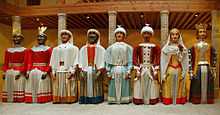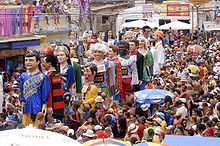Gigantes y cabezudos
Many Latin festivals include costumed figures known as gigantes y cabezudos, roughly, “Giants and Big-Heads”, or, in Catalan, gegants i capgrossos or in basque language "erraldoi eta buruhandiak". The main feature of these figures is typically their papier maché head; bodies are covered in clothing matching the costume's theme.

Gigantes

The giants are usually hollow figures several meters tall, with a painted paper maché head and arms, the rest of the body being covered in cloth and other clothing. Their frame is usually made of wood or aluminum, with carton-pierre—a mixture of papier-mâché and plaster of paris— used to make the head and hands. The frame of the body is hidden by cloth, and arms typically have no structural element to allow them to swing in the air when the giant is turned.
Within the frame is an individual controlling the giant. He carries a harness on his shoulder that is linked to the internal structure, and will move and shake the giant in a dance, usually accompanied by a local marching band. Typically, these dances will include at least two giants, the male gigante and the female giantess, called giganta or gigantona, though some towns have multiple couples.
The figures usually depict archetypes of the town, such as the bourgeois and the peasant woman, or historical figures of local relevance, such as a founding king and queen, or pairs of Moorish and Christian nobles.
Cabezudos
Cabezudos are smaller figures, usually to the human scale, that feature an oversized, carton-pierre head. The heads are worn with a matching costume. The person dressed as cabezudo will use one hand to hold his head, while the other hand carries a whip or pig bladder, used to frighten children or young women. Seeing through the “mouth” of the head, he will chase after these people, though he might pause to calm a frightened child.
As with the giants, the cabezudos typically represent archetypes of their town.
Other fiesta figures

- Bonecos of Olinda, Brazil
- Celedón
- Gargantua
- Judas and Judesa
- Mari-Jaia, gigante of modern fiestas of Bilbao
- Olentzero
- Paliqueiro, a kind of Galician cabezudo
- Peropalo
- Toro de fuego
- Zaldiko
- Zanpantzar
- Joaldun
Zarzuela
Gigantes y cabezudos is also the title of a zarzuela, or light opera, set during the festival of the Fiestas del Pilar in Saragossa. The zarzuela focuses on the stereotypical character of the Aragonese, strong and stubborn.
Gallery
-

Gigantes of Barakaldo, Spain
External links
| Wikimedia Commons has media related to Figures of giants. |
- Giants and big heads group in San Sebastian
- Madrid´s group
- Valladolid´s group - Giants and big heads
- International Circle of Friends of Giant Puppets
- Giants of Lleida Friends Assotiation
- Gigantes y cabezudos of Zaragoza
| ||||||||||||||


